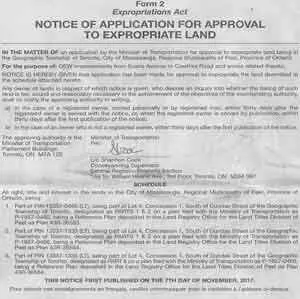
Expropriation
According to section 1 of the Expropriations Act, expropriation means “the taking of land without the consent of the owner by an expropriating authority in the exercise of its statutory powers”[i]. Considering that land ownership is a cornerstone of our society, the ability of the government to take an owner’s land is a terrifying thought, and rightly so.
Since expropriating an owner’s land is such an extreme measure there are several steps that must be taken before an expropriation can occur. A landowner will have an opportunity to get involved in the pre-expropriation process and in doing so may prevent the expropriation process from even beginning.
The follow is an overview of the steps involved in the entire process. In this overview we will assume the Ministry of Transportation is considering obtaining land owned by someone else to expand a highway.
Expropriation Step 1: Environmental Study Report
Prior to beginning the expropriation process a study must be completed to determine the need and justification of the proposed undertaking (undertaking refers to an activity, proposal, plan or program) along with the property required to achieve the goals of the project. This is enshrined in the Environmental Assessment Act, Section 3, Application of the Act.
In essence this study is designed to determine if using land owned by someone else is necessary by exploring the alternative methods of carrying out the undertaking. During this stage there is a consultation process, and often this is when a landowner will hear about a potential expropriation.
The landowner has an opportunity, through the public consultation process, to influence the decision made by the Ministry of the Environment by recommending alternative solutions to the undertaking, if possible. The landowner should consult with experts who may be able to provide such alternatives. Of course, this can become an expensive option and is by no means guaranteed to affect the Ministry’s decision, as alternatives may not be appropriate.
Expropriation Step 2: Land use is decided to be the appropriate solution
If the Minister of the Environment decides that using the land is the appropriate process the Minister can give approval to proceed with the undertaking.
Expropriation Step 3: Pre-expropriation negotiation
Once it has been determined that the land is required for the undertaking most authorities will attempt to negotiate a purchase price with the landowner before moving to expropriation. Another option at this stage is that the landowner may decide to transfer part of his or her property for an advance payment without losing the right to obtain full compensation for damages/losses incurred by the expropriation at a later date.
Expropriation Step 4: Notice of Application for Approval to Expropriate Land
If the negotiation does not succeed the next step is for the expropriating authority, in this example the Ministry of Transportation, to serve the registered owner with a Notice of Application for Approval to Expropriate Land. This notice must be published once a week for three consecutive weeks in a newspaper published in the area in which the land is located that has sufficient circulation. At this stage one of two things can happen: the landowner requests a Hearing of Necessity, or if no hearing is requested, the decision is made to expropriate and a certificate of approval is provided to the expropriating authority. View an example of this notice
Expropriation Step 5: Hearing of Necessity
A landowner has 30 days to file an appeal, referred to as a Hearing of Necessity. In this hearing the expropriating authority, in this example the Ministry of Transportation, must prove that the expropriation is necessary. A major problem with this hearing is that the inquiry officer (the person appointed by the Chief Inquiry Officer) doesn’t have the power to make binding decisions. Rather the inquiry officer makes non-binding recommendations to the approving authority. This can ultimately affect the process if the approving authority decides to amend its decision, but it is in no way guaranteed.
Expropriation Step 6: Register Plan of Expropriation (within 3 months)
Once approved, the expropriating authority, in this example the Ministry of Transportation, must file the Plan of Expropriation with the Registry Office. This is a significant step because it immediately vests or confers ownership of the land to the expropriating authority. At this stage the landowner is typically still in possession of the property, but is no longer the legal owner of the land.
Expropriation Step 7: Serve Notice of Expropriation, Notice of Election and Notice of Possession (within 30 days of registering the Plan of Expropriation)
Notice of Expropriation: notifies the landowner that ownership has been expropriated
Notice of Election: allows the owner the right to elect a valuation date for the purpose of compensation
Notice of Possession: this will specify a date for possession by the expropriating authority, that is at least 3 months after the date of serving the Notice of Possession
Expropriation Step 8: Statutory offer of compensation – Section 25 of the Expropriations Act
Within 3 months of registering the Plan of Expropriation the expropriating authority must serve the owner with an offer of compensation along with the appraisal of the land’s market value. If this offer is accepted then final compensation is paid.
Expropriation Step 9: Negotiation to resolve compensation
If the offer is not accepted by the owner a formal negotiation proceeding will commence. This process can ultimately be arbitrated by the Ontario Municipal Board, and if the owner is still not satisfied, appealed to divisional court. The Expropriations Act contains a provision that will reimburse an owner for the reasonable costs associated with determining compensation and injurious affection, as described next.
It must be noted that this step is about compensation, nothing else. In addition, the owner is entitled to claim injurious affection within one year after the damage was sustained or become known to the owner. Injurious affection is defined in section 1 of the Expropriation Act[ii] as:
(a) where a statutory authority acquires part of the land of an owner,
(i) the reduction in market value thereby caused to the remaining land of the owner by the acquisition or by the construction of the works thereon or by the use of the works thereon or any combination of them, and
(ii) such personal and business damages, resulting from the construction or use, or both, of the works as the statutory authority would be liable for if the construction or use were not under the authority of a statute,
(b) where the statutory authority does not acquire part of the land of an owner,
(i) such reduction in the market value of the land of the owner, and
(ii) such personal and business damages,
resulting from the construction and not the use of the works by the statutory authority, as the statutory authority would be liable for if the construction were not under the authority of a statute, and for the purposes of this clause, part of the lands of an owner shall be deemed to have been acquired where the owner from whom lands are acquired retains lands contiguous to those acquired or retains lands of which the use is enhanced by unified ownership with those acquired; (“effet préjudiciable”)
Conclusion
First, nothing I’ve written is legal advice, rather it is an overview of the process from a layman’s perspective.
Looking for a visual representation of expropriation? Click here to view a great flowchart from the Ontario Expropriation Association.
The process of expropriating land is serious and can have a significant effect on a landowner. A landowner whose land is potentially being or is in the process of being expropriated needs to understand the process, including what he or she can do, and how compensation is determined.
Step 4 Example – this is the text of a notice published in the Toronto Star on November 7, 2017:
Form 2
Expropriations Act
NOTICE OF APPLICATION FOR APPROVAL
TO EXPROPRIATE LAND
IN THE MATTER OF an application by the Minister of Transportation for approval to expropriate land being in the Geographic Township of Toronto, City of Mississauga, Regional Municipality of Peel, Province of Ontario
For the purpose of: QEW improvements from Evans Avenue to Cawthra Road and works related thereto.
NOTICE IS HEREBY GIVEN that application has been made for approval to expropriate the land described in the schedule attached hereto.
Any owner of lands in respect of which notice is given, who desires an inquiry into whether the taking of such land is fair, sound and reasonably necessary in the achievement of the objectives of the expropriating authority, shall notify the approving authority in writing.
a) in the case of a registered owner, served personally or by registered mail, within thirty days after the registered owner is served with the notice, or, when the registered owner is served by publication, within thirty days after the first publication of the notice;
b) in the case of an owner who is not a registered owner, within thirty days after the first publication of the notice
The approving authority is the Minister of Transportation
Minister of Transportation Per:
Parliament Buildings
Toronto, ON M7A 1Z8 __________________________
c/o Shannon Cook
Conveyancing Supervisor
Central Region – Property Section
159 Sir William Hearst Ave., 3rd Floor, Toronto, ON M3M 0B7
SCHEDULE
All right, title and interest in the lands in the City of Mississauga, Regional Municipality of Peel, Province of Ontario, being:
- Part of PIN 13337-0466 (LT), being part of Lot 4, Concession 1, South of Dundas Street of the Geographic Township of Toronto, designated at PARTS 1 & 2 on a plan filed with the Ministry of Transportation as P-1857-0465, being a Reference Plan deposited in the Land Registry Office for the Land Titles Division of Peel as Plan 43R-36563.
- Part of PIN 13337-1333 (LT), being part of Lot 4, Concession 1, South of Dundas Street of the Geographic Township of Toronto, designated as PARTS 1 & 2 on a plan filed with the Ministry of Transportation as P-1857-0466, being a Reference Plan deposited in the Land Registry Office for the Land Titles Division of Peel as Plan 43R-36564.
- Part of PIN 13337-1334 (LT), being part of Lot 4, Concession 1, South of Dundas Street of the Geographic Township of Toronto, designated as PART 6 on a plan filed with the Ministry of Transportation as P-1857-0466, being a Reference Plan deposited in the Land Registry Office for the Land Titles Division of Peel as Plan 43R-36564.
THIS NOTICE FIRST PUBLISHED ON THE 7TH DAY OF NOVEMBER 2017
Pour obtenir ces renseignements en français, veuillez communiquer avec le minstere à l’adresse ci-dessus.
[i]Expropriations Act, R. S. O. 1990 c E.26, Section 1 (1), https://www.ontario.ca/laws/statute/90e26#BK0
[ii] Ibid



